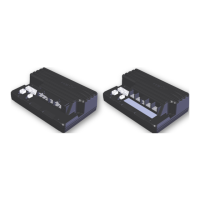GBK51948 RHINO2
Installation Manual Issue 5
5.7.1 Battery charger connections
Warning
l
The scooter manufacturer should comply with the requirements of ISO7176, Part 25 regarding batteries
and chargers.
l
The maximum charging current for the RHINO2 scooter control system is 8A RMS.
l
The scooter manufacturer must specify an appropriate battery charger for the batteries used in the
scooter.
l
The scooter manufacturer must specify the maximum current of any battery chargers to be used with
the controller and warn against using battery chargers of higher current ratings.
l
The battery charger must have over-current protection in the form of a non-resettable fuse, which does
not self-reset until the fault is cleared.
l
It is the responsibility of the scooter manufacturer to manage the risks of battery over-charging and any
related gas emissions.
l
To protect the scooter wiring from over-currents while charging the batteries, chargers must have the
ability to reduce their current output when electrically shorted.
There are two options for connecting a battery charger, either on-board (OBC) or off-board.
For examples of wiring, see below. If an on-board charger is installed, it is recommended to
plug it directly into the Charge/Program connector. For either charging solution, a battery
charger with a maximum rating of 8 A RMS should be used. A suitable fuse (with a
maximum rating of 8 A) must be installed in the Battery Positive wire to protect the scooter
wiring.
For off-board chargers, an XLR-type socket can be connected either through the
Charge/Program connector or through the tiller by using the Battery + and Battery -
connections on the tiller connector.
Warning
To prevent driving while charging, an appropriate inhibit pin (in either the Charge/Program or Tiller connector)
must be connected so that a connection between Battery Negative (B-) and Inhibit is made when charging. For
off-board chargers, this connection must be made as soon as the charger is connected to the scooter,
independent of the charging state.
Warning
The battery charger socket is to be used exclusively for the intended purpose. Warranty will be voided if any
unauthorised device is connected to this port.
Charger inhibit functionality is available on pin 14 and pin P/I of the Multifunction Inputs.
Set the corresponding Pin [x] Function parameter to 'Charger Inhibit' and set its Active state
to 'Low'.
Warning
It is the manufacturer's responsibility to ensure that any configurable interface pin that is to be used as a
Battery Charger Inhibit pin is correctly configured and tested. The maximum voltage on the inhibit pin must not
exceed 3 V if a battery voltage is to be detected when the battery charger is connected.
Page 30 - Installation and testing

